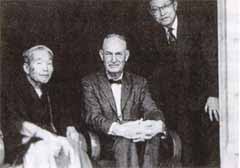- Home
- Natto Encyclopedia
- Colonel Howe Saved Natto After World War II
History of developments of natto
Colonel Howe Saved Natto After World War II
It has been half a century since then.
On August 15, 1945, the long agonizing World War II ended with Japan’s defeat.
Relief did not last long. Unprecedented food shortages came. There just was not any food. On November 1 of the year the war ended, there was a mass meeting to deal with death-from-starvation at Hibiya Park when many people starved to death all over Japan, especially in cities.
Black markets were popping up in many places, and people living in cities went out to local areas looking for food and getting them in barter trade in exchange of their Sunday best and precious metals in order to keep their family’s wellbeing. Against such a background, a sad incident happened.

1959
Visit to the home of Dr. Tadasu SAEKI
Colonel Howe (Center)/Mr. Toshio OISO (Right)
Rare nutritionist in the Army Medical Service broke left leg in a sudden traffic accident, was hospitalized and treated, and then resumed his official duties.
In 1947, after declaring “Now, judges and prosecutors must defend the dignity of law,” Judge Yositada YAMAGUCHI of Tokyo District Court refused any food from black markets, bravely lived only on rationed food, and died from malnutrition.
At that time, in the General Headquarters of the Allied Forces (GHQ), there was an American army officer who was deeply concerned about malnutrition of the Japanese people. It was Colonel Howe, the nutrition manager, who was disappointed with the thinking of bureaucrats after seeing the useless reconstruction plan prepared by the Ministry of Agriculture and Forestry. After studying the Japanese food culture, he took notice of natto. He actively gathered information from scholars of natto and business persons.
As a result, Colonel Howe came to the conclusion that “Natto is the best to give the necessary nutrition to Japanese people more economically, efficiently and readily at hand.”
Nutrition manager at GHQ is an important position in charge of the overall food policy in Japan but Colonel Howe himself went to Sendai in August 1947 to meet Professor Shoji KONDO of School of Medicine at Tohoku University, and learned about natto in detail.
Partly due to the backup of the GHQ, Japanese government became to highly value natto as part of the measures to deal with food crisis. In this way, the postwar history of natto started.

